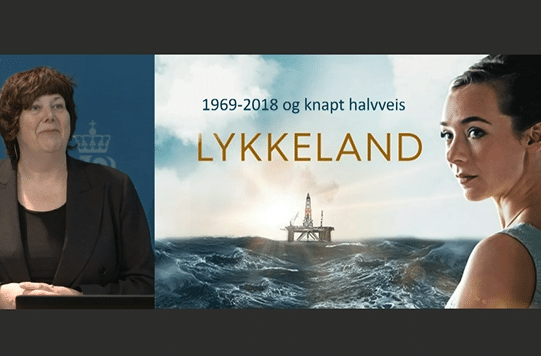Bente Nyland, Norwegian Petroleum Directorate’s Director General, presented mostly good news from the Shelf in 2018. With great enthusiasm about the high activity she looked back at 2018 and showed forecasts for 2019.
Production and development
The NPD’s forecasts show that, after a minor decline in 2019, oil and gas production will increase from 2020 and up to a record in 2023. Worth noting is that gas production is taking up more than half of the total. Looking further ahead to 2030 however shows that reserves are rapidly declining after this peak and the undiscovered resources become much more important. So, there is certainly no time to sit back and celebrate the future record.

Production of oil and gas comes from 83 producing fields on the Norwegian Shelf. One of these – Aasta Hansteen – came on stream in December 2018.
Three new plans for development and operation (PDOs) were submitted last year, while nine plans were approved. Seven of these relate to field developments linked to existing infrastructure and two new stand-alone facilities: Johan Castberg and Yme.
Exploration
These are the facts from the NPD: exploration activity was considerably higher last year in than in the two previous years. The number of exploration wells has increased dramatically, and 87 new production licences were awarded, which is a new record.

A total of 53 exploration wells were spudded last year, compared with 36 in 2017. The companies’ plans show that this number will probably remain at the same high level in 2019. Eleven discoveries were made, with a preliminary resource estimate of 82 million standard cubic metres of recoverable oil equivalents (o.e.). This is higher than each of the three previous years.
“The high level of exploration activity proves that the Norwegian Shelf is attractive. That is good news! However, resource growth at this level is not sufficient to maintain a high level of production after 2025. Therefore, more profitable resources must be proven, and the clock is ticking,” says Nyland.
So yes, there are signs that exploration is picking up its pace again and that is great news. But looking back on 2018 the industry should not be too happy with its performance. Activity, the number of exploration wells and discovered resources are compared to 2016 and 2017 which were historically bad years for exploration on the NCS.
Additionally, almost half of the 53 wells are appraisal wells and most of the exploration wells were drilled close to infrastructure and could be ranked as near-field exploration. In order to find more oil and gas to keep production on a high, we need to explore far from fields as well and find those play-openers. And there is lots to find since more than half of the total resources on the NCS (15.6 billion standard cubic meters) still remains.
Read the full article and report from the NPD here.




